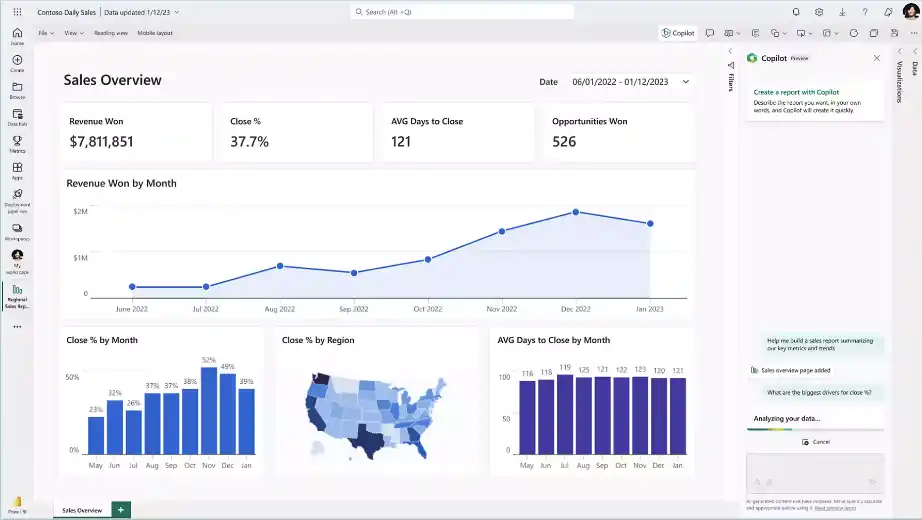Microsoft Q2 2024 Licensing Updates
Microsoft continues to deliver a stream of thrilling announcements throughout 2024!
3 min read
Dave Rowe Jun 13, 2024 2:33:05 PM

Microsoft introduced Microsoft Fabric and its related SKUs last year. As a result, the Power BI Premium per capacity SKUs will no longer be available. The good news for current Power BI Premium product customers is that the features of the Power BI Premium product will stay the same, and you don't need to do anything right now. You can keep using your current Power BI Premium capacity until it's time to renew.
Starting January 1, 2025, current Power BI Premium per capacity customers will have to switch to a Fabric capacity and pricing plan that fits their needs when they renew. This new plan gives more choice in SKU size, pay-as-you-go billing options, and access to Azure-only features.
Microsoft Fabric, launched last year, combines the best of Microsoft Power BI, Azure Synapse Analytics, and Azure Data Factory in one SaaS platform. It has all the features of Power BI Premium and six more core workloads. Customers can use their Power BI Premium per capacity licenses to access Fabric capabilities.
Microsoft Fabric now offers both pay-as-you-go and reservation options, and as a result, Microsoft will phase out the Power BI Premium capacity SKUs. Customers who already have Power BI Premium capacity can buy more under their current contract until it ends. Upon agreement renewal, the impact of the retirement will vary based on your existing agreement:
This retirement does not affect Power BI Pro and Power BI Premium per user (PPU). For Power BI Embedded, you can use Microsoft Fabric capacity for all your embedded activities. See the blog “Power BI Embedded with Microsoft Fabric” for more details.
One important thing to note about Microsoft Fabric capacity is that it is not compatible with Power BI Report Server. To continue accessing Power BI Report Server, you can instead acquire it through SQL Server Enterprise Edition with Software Assurance. This option is the most popular way of acquiring Power BI Report Server.
To learn more about this change and how to migrate your Power BI capacity purchases to Fabric capacity, view the Power BI Premium FAQ.
Fabric capacity offers many advantages to customers who switch their purchase from Power BI Premium. Fabric has a flexible pay-as-you-go option that allows organizations to adjust and pause capacity as needed. Fabric also has smaller compute SKUs that are much lower than the lowest Power BI Premium SKU.
Moreover, Fabric users can access Azure-only features like trusted workspace access for OneLake shortcuts and Managed Private Endpoints for Spark. These features are only available in Azure and not available to Power BI Premium capacity customers.
You can see all Microsoft Fabric SKUs available in your Azure region on the Microsoft Fabric pricing page.
The affected Power BI Premium capacity SKUs will eventually require migration, but the timing is based on the renewal date of the agreement. Customers who renew their agreement before January 1, 2025, can renew their Power BI Premium capacity SKUs for another year. Customers whose agreement expires after January 1, 2025, will have to buy Fabric capacity. You will, however, still be able to access your Power BI and Fabric artifacts for at least 90 days after the expiration of their Power BI Premium capacity subscription.
During this 90 day grace period, you can move your workspaces to your new Fabric capacity without worrying about losing your existing work. To move your Power BI and Fabric artifacts, you just need to reassign your workspaces to the new Fabric capacity. Administrators can also use bulk assign workspaces to speed up the process. Find out more about how to manage and reassign your workspaces in the Microsoft Fabric documentation.
The migration process is straightforward, but it can cause disruption. Customers need to buy and set up new Fabric capacities, transfer their Power BI workspaces, and recreate scheduled jobs. Even though the risk is low, it demands testing and takes users' attention away from other tasks.
You don’t have to navigate understanding Fabric licensing or the migration of your existing Power BI workspaces alone! As a trusted partner, CloudServus has experts on hand with extensive experience in migrating Power BI workspaces. With CloudServus as your partner, you can confidently and seamlessly migrate your Power BI workspaces, knowing that you are in capable hands. Contact us today to get started.

Microsoft continues to deliver a stream of thrilling announcements throughout 2024!

For all of you out there wondering what the freshly launched Microsoft Fabric means if you’re already using Power BI, stay put.

*Updated 11/5/2021